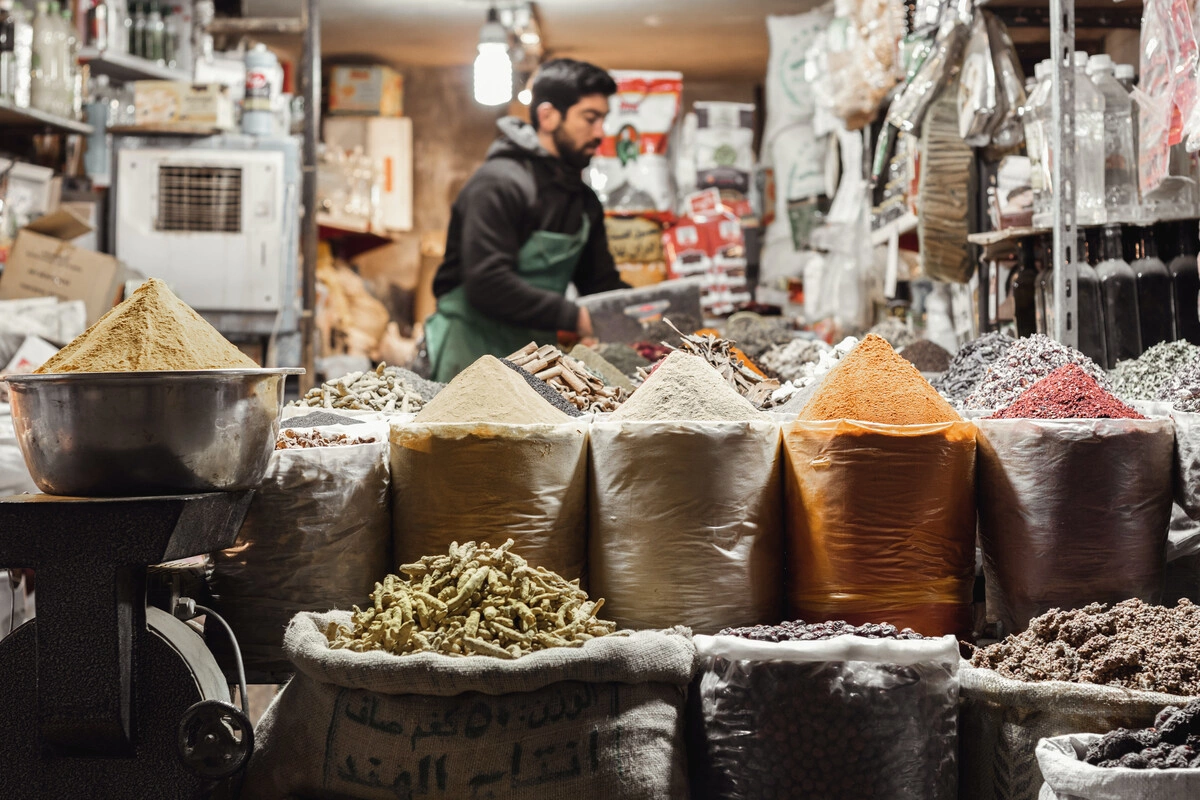
This is truly a region where home-grown culinary traditions remain paramount.
Packing spices in northwestern Iran. Photo: Ashkan Islami
With four alphabets, dozens of languages and several geopolitical fault-lines, it can be all too easy to focus on differences when looking at the Caucasus-Caspian region. But that means missing a great raft of cultural similarities. This is especially true of the food. While you’ll be hard-pressed to find a Caspian Cookbook, and each country is justifiably brimming with pride over its national cuisine, the reality is that many great recipes are common to large swathes of the region, albeit with regional tweaks and local twists. This is truly a region where home-grown culinary traditions remain paramount. Sure, the cosmopolitan cities like Baku and Tbilisi have countless coffee-shops and wide-ranging international restaurants, while Rasht is home to one of Iran’s finest Italian chefs. But what the region does best is its own thing.
In coming articles, The Caspian Post looks forward to tantalizing your taste-buds with a luscious selection of this fabulous, oft-overlooked food culture. But to kick things off, we’d like to take your gustatory impulses on a whistle-stop tour, outlining the blurred lines and common themes that joyously unite the region.
Throughout the Caspian region, nothing better signifies a celebration than the roasting of meat on a barbecue. Widely known as shish kebab (from Turkish) or shashliq (from Russian), the most prevalent variant is skewered lamb, known as tike in Azerbaijan and chanjeh in Iran. Often substituting hunks of pork, the same basic dish is known as mstvadi in Georgia or khorovats in Armenian. Iranian restaurants regularly feature barbecued jujeh (chicken marinated in turmeric and lemon) but especially kubideh, minced lamb pressed onto the skewer and served on buttered rice with raw sweet onion. The same basic kebab is known in Azerbaijan as lule but served with thin sheets of bread and a sprinkling of sumac. Delicious.
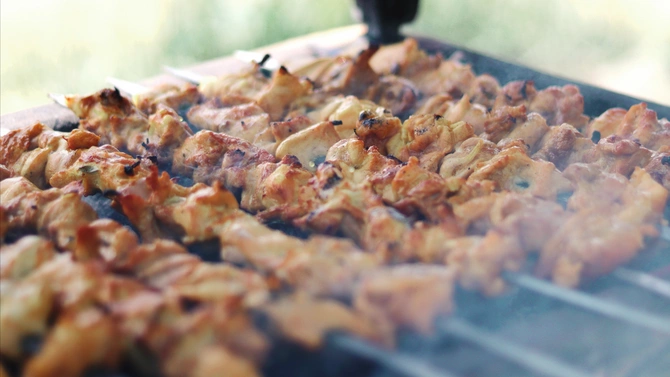
Chicken grilled over hot coals in Ardabil, Iran. Photo: Habib Dadkhah
Yes. The Caspian region encompasses swathes of steppe land. But the southwestern quadrant of the area is contrastingly lush and fertile, groaning with an abundance of fruit and produce. Georgia is a cradle of world wine culture. Azerbaijan grows everything from apples to tea, with orchards of pomegranates and fields of sun-packed tomatoes. The climate is at its rainiest and most fecund in Iran’s Gilan area, where vegetable gardens and even the odd rice paddy shatter all those desert preconceptions. Food in these countries abound in fresh fruit, fragrant herbs and unexpected herb-spice combinations, none better than the counterpoint of aubergine (eggplant), walnut and pomegranate. You’ll find this combination in many aubergine roll starters where garlic-charged walnut paste is wrapped in thin sheets of fried aubergine and garnished with pomegranate. Arguably the most defining dish in Persian cuisine is fesinjun, tender chicken in a rich, tangy sauce made from pomegranate molasses and ground walnuts, a meal that’s strikingly similar to Georgia’s equally scrumptious satsivi.
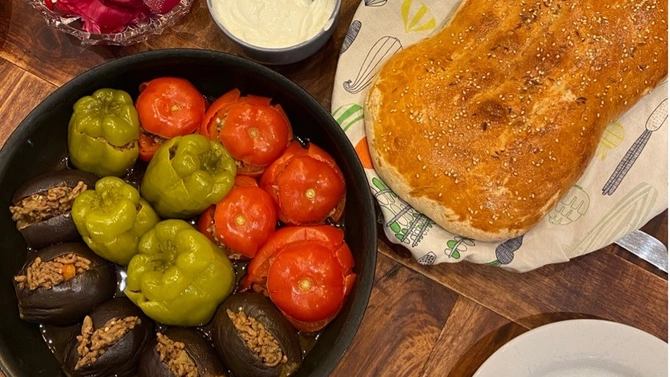
"Three sisters dolma" is an Azerbaijani dish of stuffed tomatoes, peppers, and aubergine. Served with yogurt and bread. Photo: Javahir Ahmadova
Used separately, whole unripe walnut-fruits make the basis for a unique Caucasian ‘jam’ whose black ball appearance will baffle first-timers. Pomegranates are the basis for a marvellously tart Azerbaijani condiment called narsharab which majestically sets off the flavour in many fish dishes, while fresh-squeezed pomegranate juices are refreshing seasonal treats from street-vendors across much of Iran.
Localized originally to Iran’s Caspian provinces, though rapidly becoming more generally available, mashed roast aubergine is given an especially magical twist in starter-style dips kashke bademjun (with mint, tahini and caramelized onions) and mirza ghasimi (using egg and plenty of garlic). Aubergines are just one of many vegetables which, when filled with minced lamb, are known across virtually the whole region as dolma.
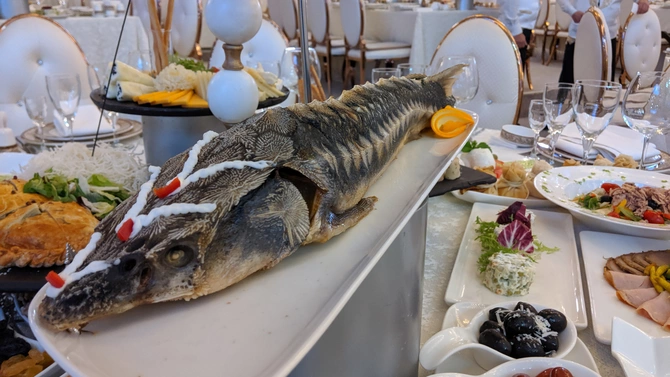
Sturgeon is now an expensive delicacy: here forming the centrepiece of a lavish wedding feast. Photo: Mark Elliott
Whether you call it a sea or a giant lake, having the Caspian as the heart of the region, you might expect fish to be a major specialty. Indeed, just over a century ago, the Caspian sturgeon was so plentiful that caviar was commonplace. Tommys stationed in Baku after WWI were reported to have complained that ‘this here jam do taste like fish’ having been given caviar on their bread. Sadly over-fishing in the 20th century radically depleted sturgeon stocks, and though tiny quantities are still produced, prices are astronomical. Sturgeon and other fish are still served at Azerbaijani weddings and in luxury restaurants. And Astrakhan remains known for a three-fish soup. However, the most commonly served fish these days tends to be farmed trout, widely known by its Russian name forel.
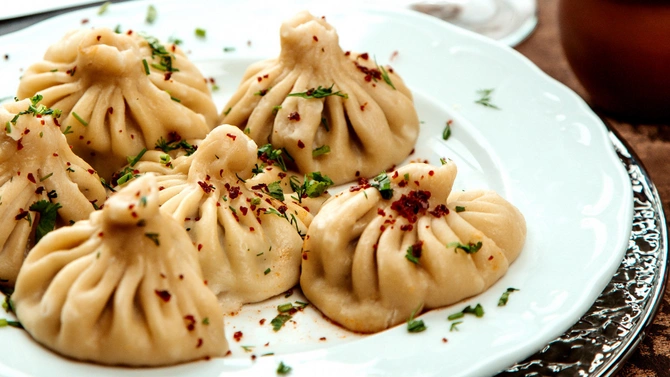
Georgian Khinkali with herbs and sumac. Photo: Kamran Aydinov
Ok, let’s be clear. The collective term “dumplings” is woefully lacking. But the English language doesn’t really have a term that can do justice to a whole category of creative dishes whose common feature is most typically fine lamb-mince wrapped in a quaveringly soft dough that’s like a lighter but thicker pasta. Some cookbooks liken these dishes to “ravioli,” a simile that works to some degree with manti, though that term itself varies greatly by region. In much of Central Asia, manti is a local take on dim sum, similar to Russian pelmeni. Armenian manti are often left open at the top, blooming into half-open tulips and baked to a crispier texture. Turkish manti are served with a slathering of melted butter, herbs and garlic-yogurt. In contrast, miniature versions served in broth are known in Azerbaijan as dushbara, a name that sounds like it might mean ‘dropped here’ – not unlikely given the sheer number served in a bowl. The term also covers many other Central Asian dumplings, shaped like ‘lambs ears’ (gosh e-barreh in Persian) and known variously across the region as joshbara, chuchvara, tushpara etc. Then there’s the bigger, bolder Georgian khinkali, little hand grenades of pasta the size of children’s fists. Traditionally each comes filled with scalding meaty juices and is eaten individually - with suitable care. These days khinkali creativity is in overdrive with whole arrays of new fillings that add not just variety but safety for the diner. And in Azerbaijan, just to confuse you, local xingal are disassembled versions, served in sauces much as in Turkish manti.
In future articles, we’ll be exploring all of the above, along with “holy” breads, rich stews, “five-finger” feasts and ubiquitous “plovs” (rice dishes). But right now, I’m off to eat… all this mouth-watering food-talk has made me too hungry to continue.
Bon Appétit!
Share on social media
This is truly a region where home-grown culinary traditions remain paramount.